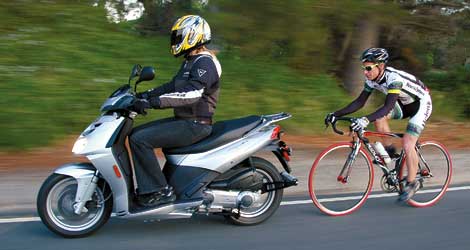Motorpacing secrets
Motorpacing is one of the most efficient and fun training methods to help build power.

Speed and explosiveness are key factors in bicycle racing. But how to improve in those two areas is up for debate. Juggling the demands of work, family, training and racing means you need to prioritize your time on the bike to the get best gains possible.
Motorpacing, the training method of riding behind a motorcycle to improve your speed, is one of the most efficient and fun training methods to help you build power. When most cyclists talk about this style of training, they’ll likely mention the pain and suffering. But as Ross Knight, a NCCP Level 3 coach in cycling and rowing based in Ottawa points out, motorpacing doesn’t need to be all about suffering. Knight emphasizes that there are many ways to integrate it into your training cycle. He says that motorpacing is flexible so you can tailor the time behind the motorcycle to suit your racing goals.
“Not all motorcycle training has to be fast. Before key events, it’s nice for the cyclist to ride behind the motorcycle at about 8-10 kph less than race pace,” says Knight. This is a great way to get a fast ride without a lot of effort.
Knight, a coach with more than 20 years experience, had a gradual introduction into motorpacing. He started with a moped and then graduated to his current ride – a 1982 650 Suzuki. While some people do motorpacing with a car, Knight emphasizes the best and safest way is behind a motorcycle. He cautions that using a car can be dangerous because you cannot see the road or communicate with the driver.
To keep things safe, the motorcycle driver must know the roads well. “A road that seems smooth at 30 km-h could be very bumpy at 70 km-h. Also, at those speeds, roads become very short, so it’s best to find roads with stretches that are at least 15 kms long without stop signs or major intersections.” Knight adds that your safety is the responsibility of the motorcyclist. Communication is imperative. “If it’s someone I have never ridden with, I always go over the safety rules before the ride. I tell the rider how we will approach stop signs and go over the hand signals,” says Knight.
Integrating motorpacing into your training program offers versatility. You have the option to mix up your training with the motorcycle depending on your fitness and race goals. Using the motorcycle, you can work on leg speed, do tempo work, work on explosiveness and sprinting, train with a group or even just do a smooth one hour recovery ride.
Apart from the fitness benefits, this training method also helps you learn some key bike handling skills. Even if you are an above average-sprinter, it will help you further hone your timing skills, something that cannot be done at slower speeds. Because you need precise timing to catch back onto the motorcycle, sprint timing training is perfect for motorpacing. As Knight says, “with great timing skill, your confidence on the bike increases.” Another bonus is getting comfortable with how your bike responds and feels at high speed.
No matter how you add motorpacing into your training, you’ll see benefits. But most of all, it’s fun. “Spend an hour behind the motorcycle at 70 kph and you will have a huge smile on your face. Riding down the road at 40 kph feels so slow and easy after going very fast,” says Knight.
Knight’s Favorite Motorpacing Work-Outs:
1 to 2.5 hours behind the motorcycle with no sprints, just a constant high speed ride.
1 hour fast behind the motorcycle with the last 25 per cent of the ride increasing in speed to the point the rider is just about ready to crack, and then hold it there.
1.5 to 2.5 hours behind the motorcycle, either single or in groups with an easy warm up followed by sprints past the motorcycle to designated spots on the road such as mailboxes, street signs, etc. with the motorcycle staying at a constant speed and the rider having to jump back in behind the motto when it comes by.
1 hour easy just below race pace with little energy exertion from the rider.
